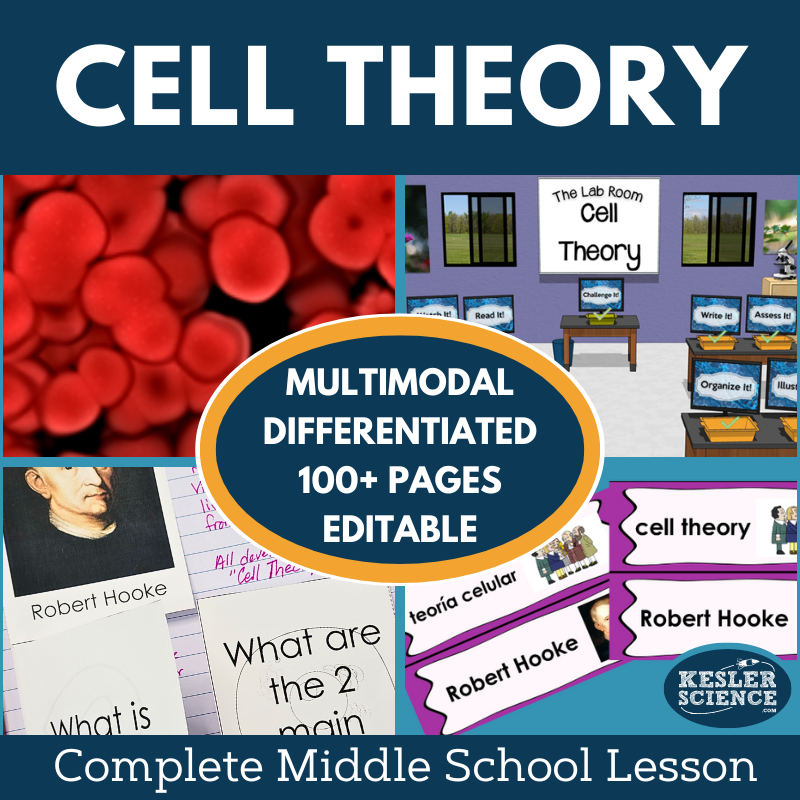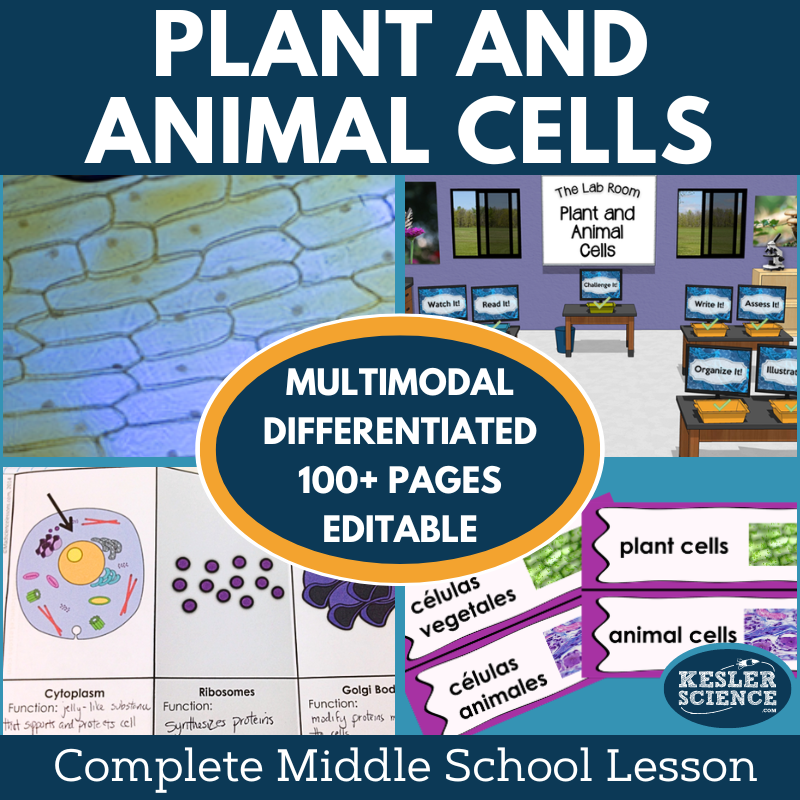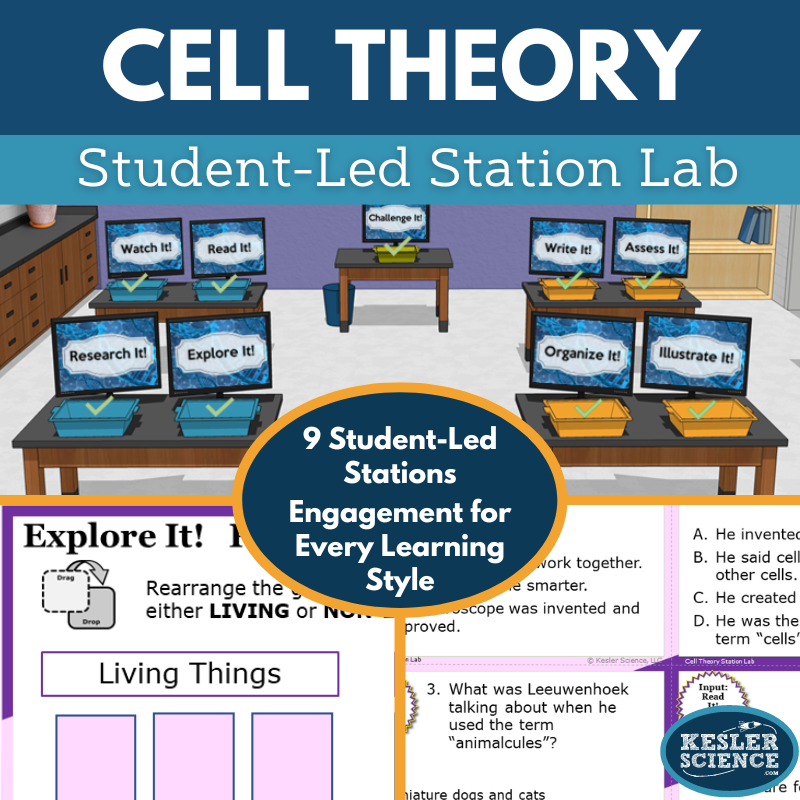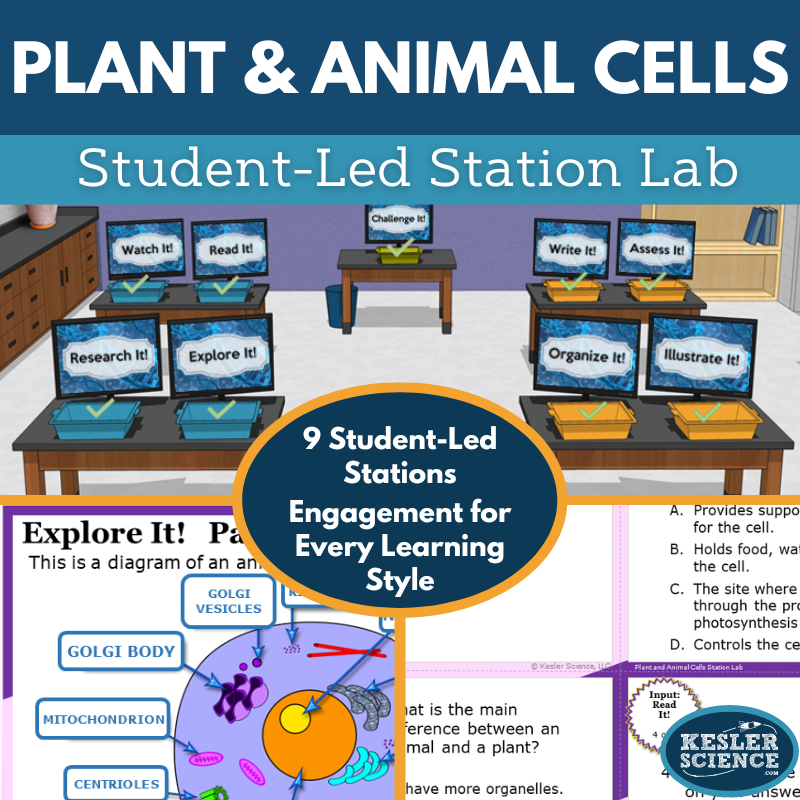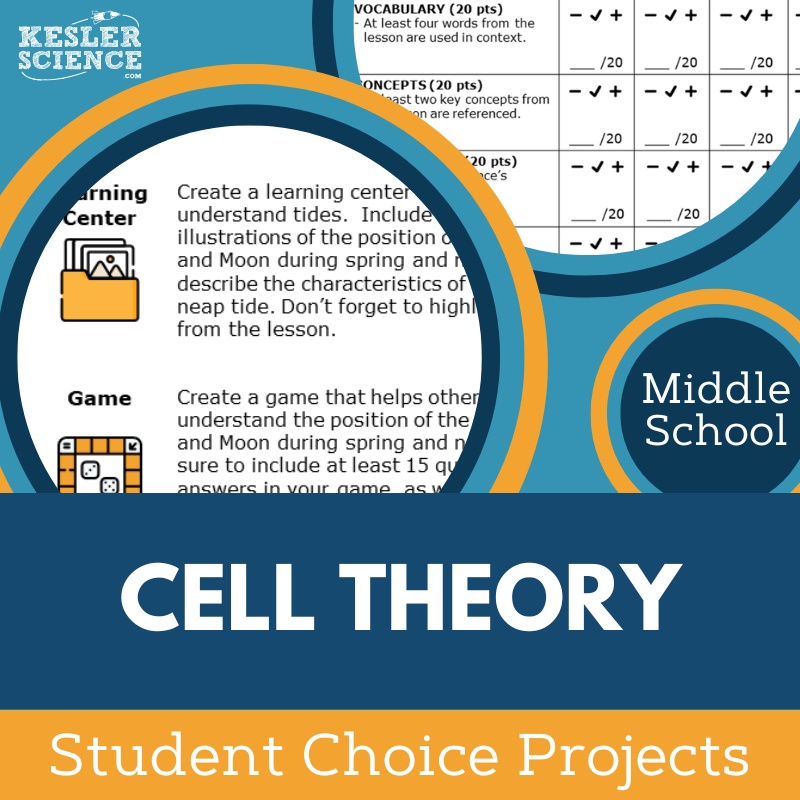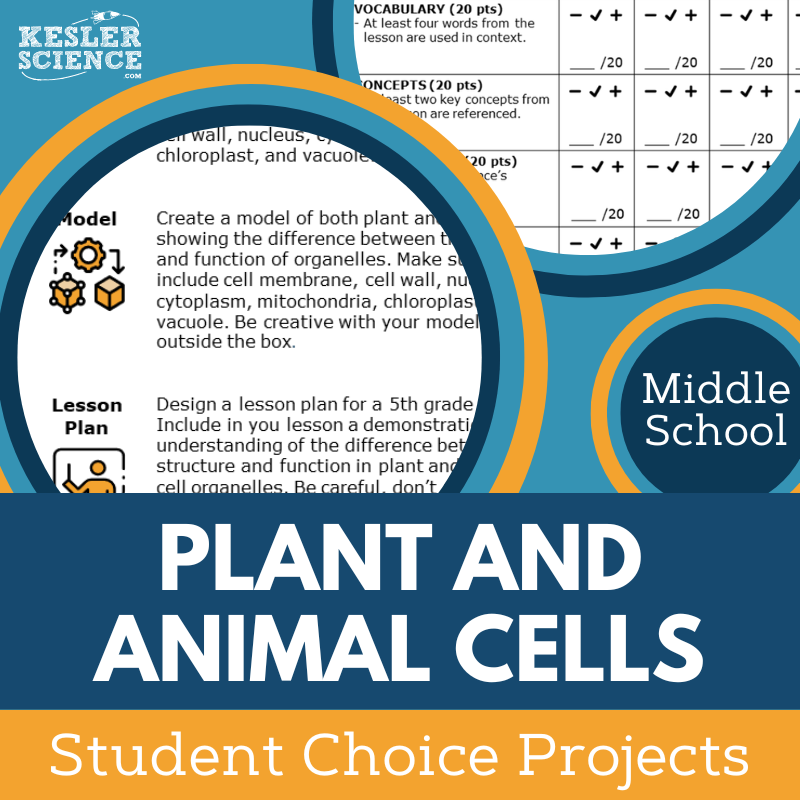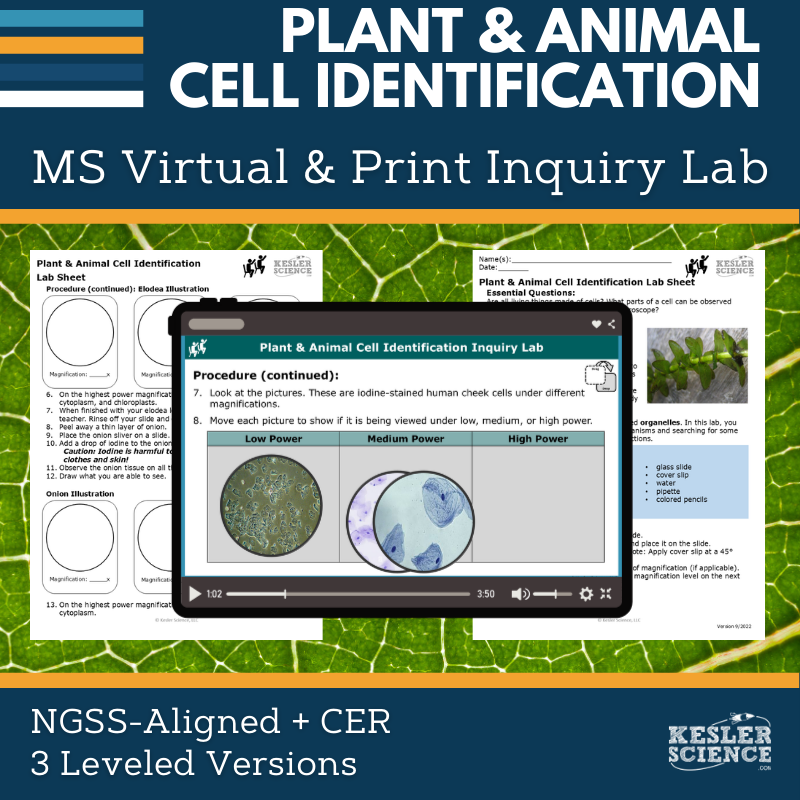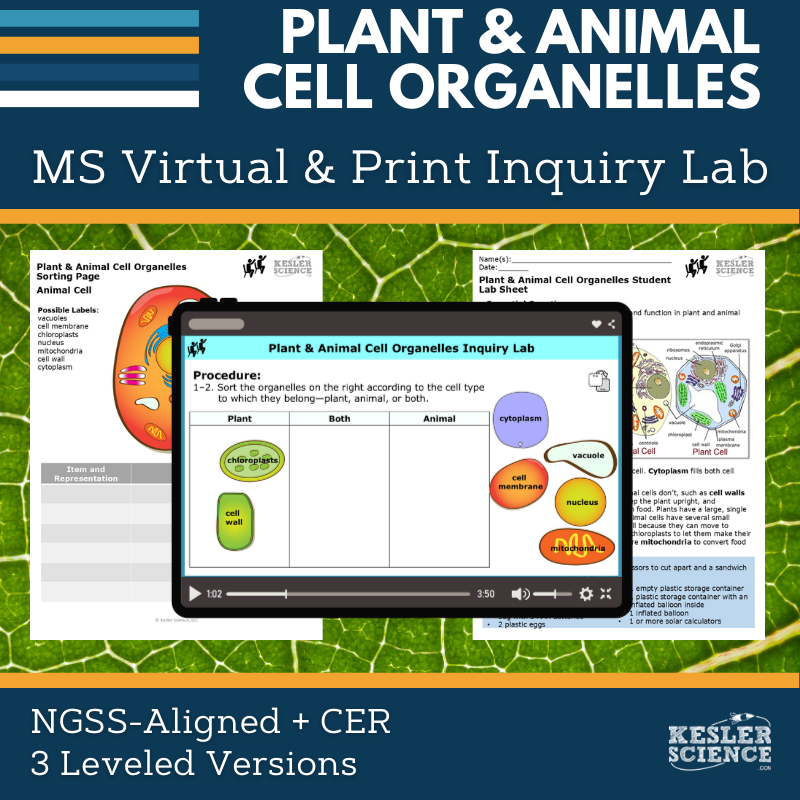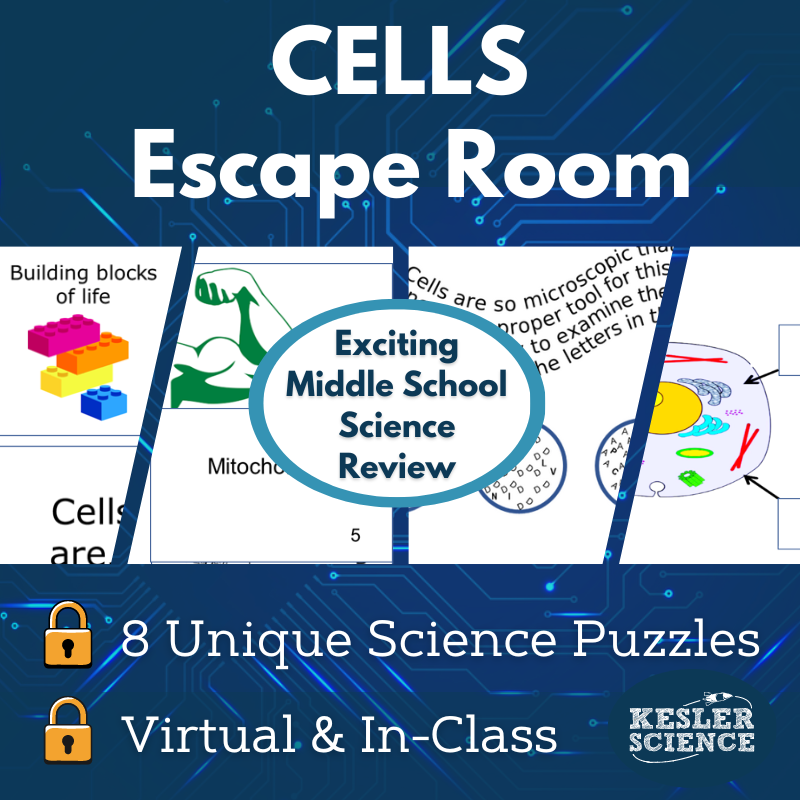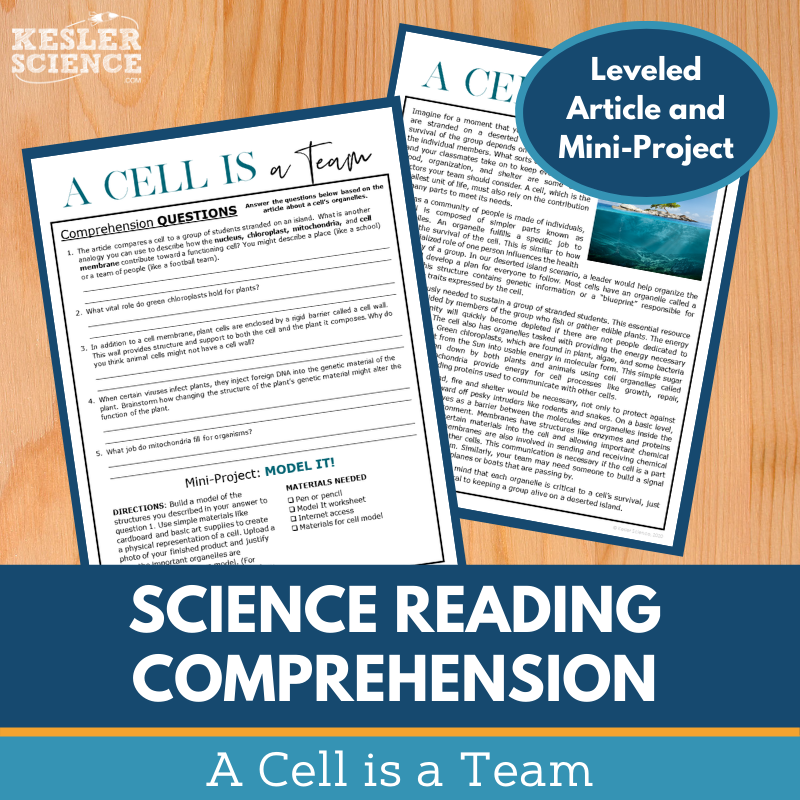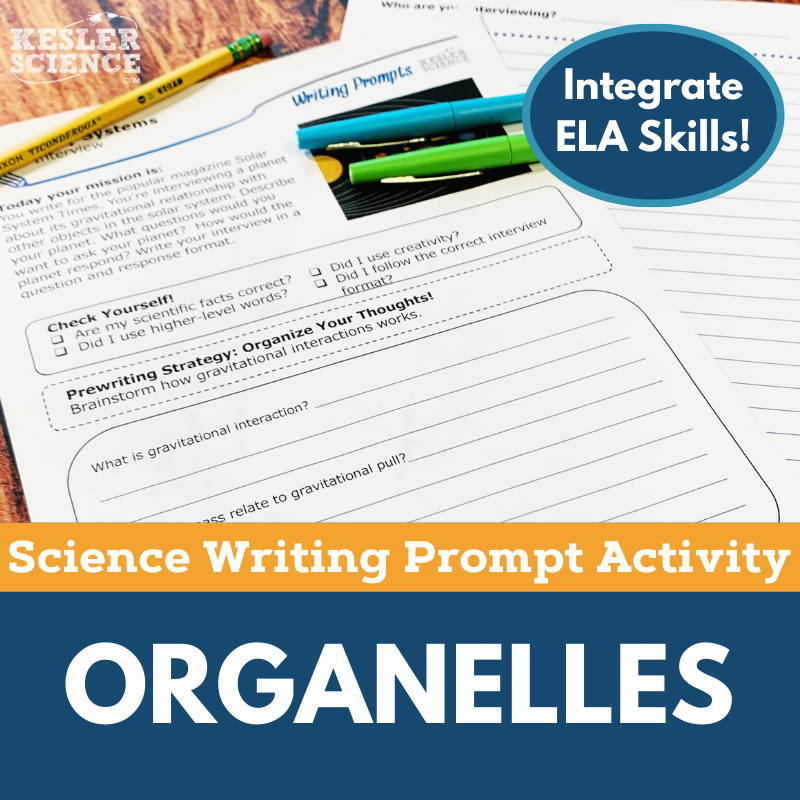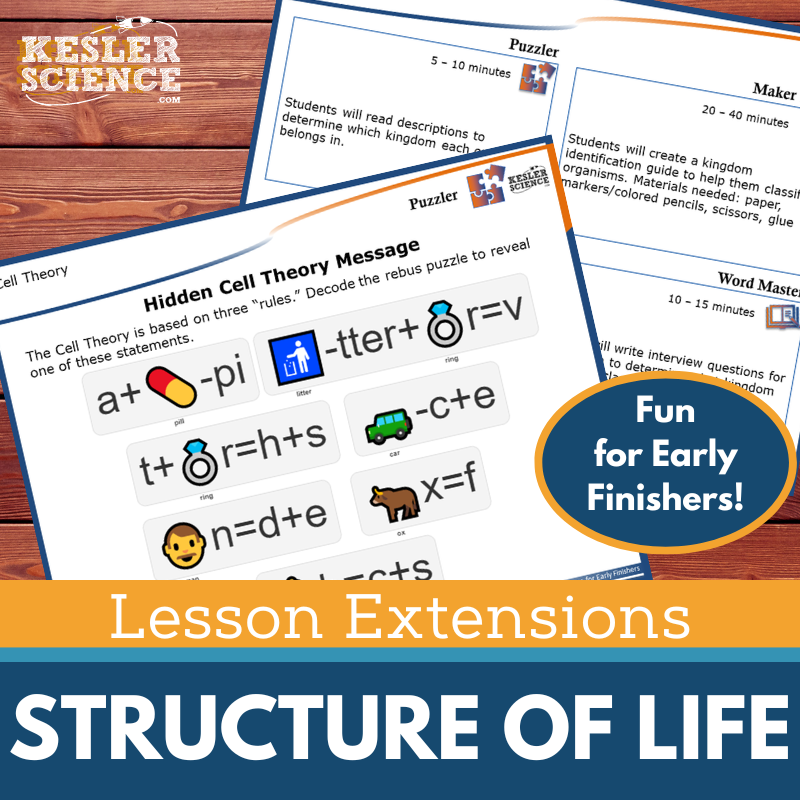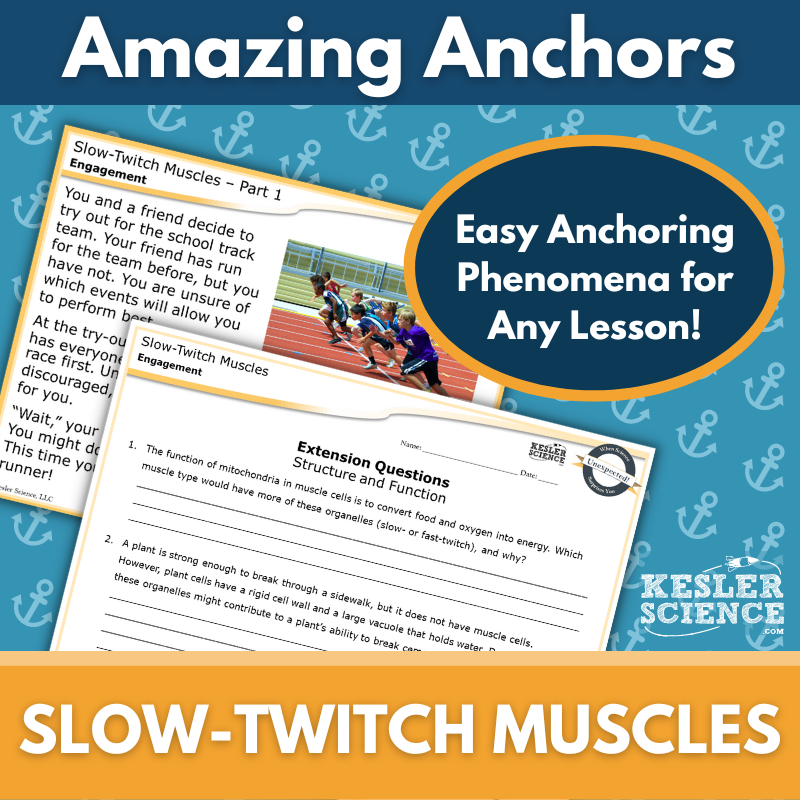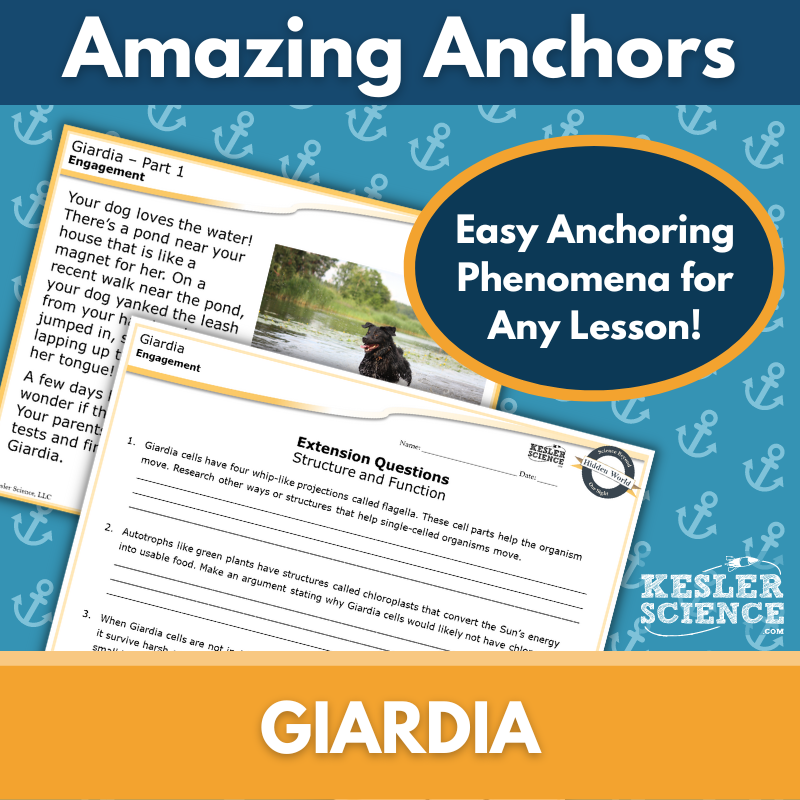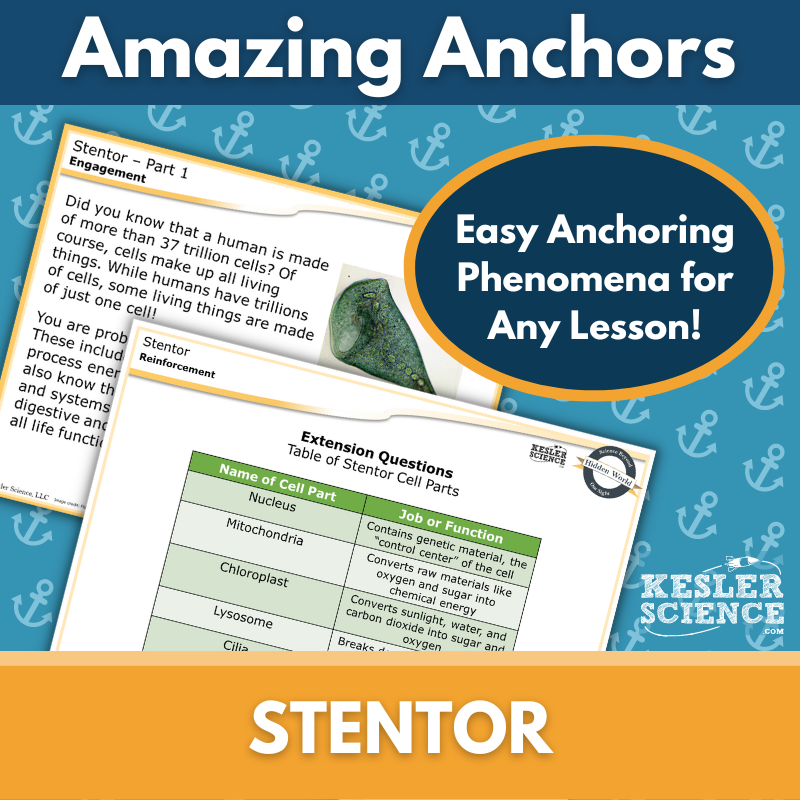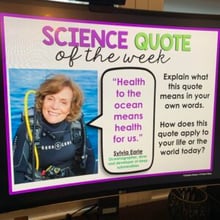Cell Parts & Functions Activities for Middle School Science
The Kesler Science Cell Theory and Plant and Animal Cells 5E Lessons provide comprehensive, student-led units for middle school, integrating editable presentations, worksheets, choice projects, and assessments within the 5E Model: Engagement, Exploration, Explanation, Elaboration, and Evaluation. The resources below will give students a comprehensive understanding of cell parts and their functions. All of the following materials are also included in the Kesler Science Membership.
The Kesler Science Cell Theory 5E Lesson is a comprehensive, student-led unit designed for middle school. It includes editable presentations, worksheets, choice projects, and assessments, all structured around the 5E Model: Engagement, Exploration, Explanation, Elaboration, and Evaluation. The lesson is fully differentiated and supports multimodal learning, ensuring accessibility for all students.
Students will explore essential questions about cell theory and the common functions of all cells. The unit features an engaging station lab with nine stations, offering hands-on activities, reading passages in English and Spanish, research tasks, videos, and interactive categorization exercises. Editable PowerPoints, interactive notebooks, and note-taking templates support explanation, while student-choice projects enhance elaboration. Evaluation includes STAAR 2.0-aligned assessments, review questions, and worksheets for test prep or homework.
The lesson is flexible for both in-person and virtual learning, with digital and printable formats available. Spanish translations are provided for key materials, and all content is fully editable to fit classroom needs.
The Kesler Science Cell Theory 5E Lesson is a comprehensive, student-led unit designed for middle school. It includes editable presentations, worksheets, choice projects, and assessments, all structured around the 5E Model: Engagement, Exploration, Explanation, Elaboration, and Evaluation. The lesson is fully differentiated and supports multimodal learning, ensuring accessibility for all students.
Students will explore essential questions about cell theory and the common functions of all cells. The unit features an engaging station lab with nine stations, offering hands-on activities, reading passages in English and Spanish, research tasks, videos, and interactive categorization exercises. Editable PowerPoints, interactive notebooks, and note-taking templates support explanation, while student-choice projects enhance elaboration. Evaluation includes STAAR 2.0-aligned assessments, review questions, and worksheets for test prep or homework.
The lesson is flexible for both in-person and virtual learning, with digital and printable formats available. Spanish translations are provided for key materials, and all content is fully editable to fit classroom needs.
The Kesler Science Plant and Animal Cells 5E Lesson is a comprehensive middle school unit designed for differentiated, student-led learning with minimal prep. It includes editable presentations, worksheets, choice projects, and assessments, making it flexible for both print and digital formats. Spanish translations are available for vocabulary, reading passages, and interactive notebook pages.
The lesson follows the 5E Model, engaging students with word wall cards, class discussions, and activities. Exploration features a student-led station lab with nine multimodal stations, including hands-on experiments, reading passages, research tasks, videos, categorization activities, writing prompts, illustrations, and assessments. A bonus challenge station extends learning for early finishers. Explanation includes editable PowerPoints, interactive notebooks, and note-taking templates. Elaboration offers student-choice projects, while Evaluation includes updated STAAR 2.0-aligned assessments, review questions, and worksheets.
This resource is fully adaptable for virtual learning, with digital station labs and interactive notebooks available for online use.
The Kesler Science Plant and Animal Cells 5E Lesson is a comprehensive middle school unit designed for differentiated, student-led learning with minimal prep. It includes editable presentations, worksheets, choice projects, and assessments, making it flexible for both print and digital formats. Spanish translations are available for vocabulary, reading passages, and interactive notebook pages.
The lesson follows the 5E Model, engaging students with word wall cards, class discussions, and activities. Exploration features a student-led station lab with nine multimodal stations, including hands-on experiments, reading passages, research tasks, videos, categorization activities, writing prompts, illustrations, and assessments. A bonus challenge station extends learning for early finishers. Explanation includes editable PowerPoints, interactive notebooks, and note-taking templates. Elaboration offers student-choice projects, while Evaluation includes updated STAAR 2.0-aligned assessments, review questions, and worksheets.
This resource is fully adaptable for virtual learning, with digital station labs and interactive notebooks available for online use.
Engage your middle school students with this student-led station lab on cell theory, designed to foster independent learning. Through a structured yet flexible approach, students explore and compare the characteristics of cell theory while engaging in nine interactive stations featuring multimodal activities.
Students encounter new concepts through hands-on demonstrations, research tasks, reading passages, and video analysis. They demonstrate their understanding by organizing information, illustrating models, responding to prompts, and completing assessments. A challenge station offers extension activities for early finishers, and differentiated reading passages are available in both Spanish and English.
This modular, low-prep resource includes all necessary materials for in-class or virtual learning, making it an engaging and versatile addition to your science curriculum.
Engage your middle school students with this student-led station lab on cell theory, designed to foster independent learning. Through a structured yet flexible approach, students explore and compare the characteristics of cell theory while engaging in nine interactive stations featuring multimodal activities.
Students encounter new concepts through hands-on demonstrations, research tasks, reading passages, and video analysis. They demonstrate their understanding by organizing information, illustrating models, responding to prompts, and completing assessments. A challenge station offers extension activities for early finishers, and differentiated reading passages are available in both Spanish and English.
This modular, low-prep resource includes all necessary materials for in-class or virtual learning, making it an engaging and versatile addition to your science curriculum.
This student-led station lab focuses on plant and animal cells, providing an engaging, hands-on learning experience for middle school students. Through nine differentiated stations, students explore the structure and characteristics of plant and animal cells. The stations include a variety of activities that allow students to take charge of their learning, with a challenge station for early finishers to extend their knowledge.
The stations are designed to be flexible, offering both in-person and virtual learning options. Students can engage with multimodal content, including hands-on tasks, digital tools, reading passages, videos, and research activities. The lab encourages independent or small-group work, with resources such as signage, task cards, and digital content to guide students through the activities.
As students progress through the lab, they will organize, illustrate, write, and assess their understanding of plant and animal cells. The stations are structured to foster deep learning, from exploring the basics of cell structure to demonstrating mastery through writing prompts and hands-on activities. The bonus challenge station provides advanced students with opportunities to further extend their learning with creative tasks and games. This versatile activity supports both traditional and virtual classrooms, making it a valuable addition to any middle school science curriculum.
This student-led station lab focuses on plant and animal cells, providing an engaging, hands-on learning experience for middle school students. Through nine differentiated stations, students explore the structure and characteristics of plant and animal cells. The stations include a variety of activities that allow students to take charge of their learning, with a challenge station for early finishers to extend their knowledge.
The stations are designed to be flexible, offering both in-person and virtual learning options. Students can engage with multimodal content, including hands-on tasks, digital tools, reading passages, videos, and research activities. The lab encourages independent or small-group work, with resources such as signage, task cards, and digital content to guide students through the activities.
As students progress through the lab, they will organize, illustrate, write, and assess their understanding of plant and animal cells. The stations are structured to foster deep learning, from exploring the basics of cell structure to demonstrating mastery through writing prompts and hands-on activities. The bonus challenge station provides advanced students with opportunities to further extend their learning with creative tasks and games. This versatile activity supports both traditional and virtual classrooms, making it a valuable addition to any middle school science curriculum.
The Cell Theory Student Choice Projects lesson allows middle school students to select a project that aligns with their preferred output style. A project page outlines six student-led options plus a “design your own” project, all supported by an editable rubric for teacher, peer, or self-assessment.
These flexible, multimodal projects provide creative ways for students to demonstrate their understanding. Two versions of the project page support differentiation, with modified options for students needing remediation and challenge options for advanced learners. Teachers can adjust the rubric to fit grading needs.
The projects require standard classroom supplies like paper, markers, and scissors, with many options available for digital completion. Some crafting materials may be helpful for model-building activities.
The Cell Theory Student Choice Projects lesson allows middle school students to select a project that aligns with their preferred output style. A project page outlines six student-led options plus a “design your own” project, all supported by an editable rubric for teacher, peer, or self-assessment.
These flexible, multimodal projects provide creative ways for students to demonstrate their understanding. Two versions of the project page support differentiation, with modified options for students needing remediation and challenge options for advanced learners. Teachers can adjust the rubric to fit grading needs.
The projects require standard classroom supplies like paper, markers, and scissors, with many options available for digital completion. Some crafting materials may be helpful for model-building activities.
The Plant and Animal Cells Student Choice Projects lesson offers middle school students a variety of creative ways to demonstrate their understanding of cell structure. The lesson includes six project options along with a "design your own" choice, allowing students to tailor their work to their preferred output style. The accompanying grading rubric provides a flexible assessment tool that can be used by teachers, peers, or students themselves. Teachers can also modify the rubric to better suit their grading needs. The projects cater to different learning levels, with a modified version available for students needing remediation and more challenging options for advanced learners.
These projects are designed to use basic classroom supplies like paper, markers, and scissors, with many options also available for digital completion. The multimodal nature of the projects encourages students to explore various methods of presenting their knowledge, whether through physical models or digital creations. This flexibility ensures that all students can engage with the content in a way that best supports their learning needs and preferences.
The Plant and Animal Cells Student Choice Projects lesson offers middle school students a variety of creative ways to demonstrate their understanding of cell structure. The lesson includes six project options along with a "design your own" choice, allowing students to tailor their work to their preferred output style. The accompanying grading rubric provides a flexible assessment tool that can be used by teachers, peers, or students themselves. Teachers can also modify the rubric to better suit their grading needs. The projects cater to different learning levels, with a modified version available for students needing remediation and more challenging options for advanced learners.
These projects are designed to use basic classroom supplies like paper, markers, and scissors, with many options also available for digital completion. The multimodal nature of the projects encourages students to explore various methods of presenting their knowledge, whether through physical models or digital creations. This flexibility ensures that all students can engage with the content in a way that best supports their learning needs and preferences.
The Plant and Animal Cells Inquiry Lab aligns with NGSS MS-LS1-2, guiding students to develop and use models to describe cell function and how organelles contribute to their roles. This lab allows for both hands-on experimentation and digital interactive activities, offering flexibility for different learning environments.
Students will observe and compare plant and animal cells, considering how their structures relate to their functions. The lab includes comprehension questions, Claim-Evidence-Reasoning (C.E.R.) prompts, and a reflection section. Differentiation is built in with three levels: Dependent (guided inquiry), Modified (structured with supports), and Independent (student-led exploration).
The print version involves a hands-on microscope investigation using materials like an elodea leaf, onion slice, cheek cells, and iodine. The digital version is an interactive PowerPoint compatible with Google Slides, requiring no materials—ideal for remote or absent students.
Editable teacher resources, answer keys, and multimodal learning strategies ensure engagement and adaptability. This lab provides a comprehensive, flexible way to explore cell structures and functions in a middle school classroom.
The Plant and Animal Cells Inquiry Lab aligns with NGSS MS-LS1-2, guiding students to develop and use models to describe cell function and how organelles contribute to their roles. This lab allows for both hands-on experimentation and digital interactive activities, offering flexibility for different learning environments.
Students will observe and compare plant and animal cells, considering how their structures relate to their functions. The lab includes comprehension questions, Claim-Evidence-Reasoning (C.E.R.) prompts, and a reflection section. Differentiation is built in with three levels: Dependent (guided inquiry), Modified (structured with supports), and Independent (student-led exploration).
The print version involves a hands-on microscope investigation using materials like an elodea leaf, onion slice, cheek cells, and iodine. The digital version is an interactive PowerPoint compatible with Google Slides, requiring no materials—ideal for remote or absent students.
Editable teacher resources, answer keys, and multimodal learning strategies ensure engagement and adaptability. This lab provides a comprehensive, flexible way to explore cell structures and functions in a middle school classroom.
This lab aligns with NGSS MS-LS1-2 and engages students in a hands-on or digital activity where they model cell organelles using household items. Students will compare plant and animal cells, discussing how their differences impact their functions. The lab includes comprehension questions, Claim-Evidence-Reasoning prompts, and a reflection section.
The lab is offered in three differentiated versions: dependent (for on-level learners), modified (for students requiring more structure), and independent (for advanced learners). The print version requires materials like organelle cards, scissors, and a few other household items, while the digital version uses an interactive PowerPoint or Google Slides, requiring no additional materials.
These materials are flexible and editable, making them easy to tailor to any classroom setting. Teacher resources, including answer keys and teacher directions, are included. The lab is available in both printable and digital formats to suit different needs.
This lab aligns with NGSS MS-LS1-2 and engages students in a hands-on or digital activity where they model cell organelles using household items. Students will compare plant and animal cells, discussing how their differences impact their functions. The lab includes comprehension questions, Claim-Evidence-Reasoning prompts, and a reflection section.
The lab is offered in three differentiated versions: dependent (for on-level learners), modified (for students requiring more structure), and independent (for advanced learners). The print version requires materials like organelle cards, scissors, and a few other household items, while the digital version uses an interactive PowerPoint or Google Slides, requiring no additional materials.
These materials are flexible and editable, making them easy to tailor to any classroom setting. Teacher resources, including answer keys and teacher directions, are included. The lab is available in both printable and digital formats to suit different needs.
The Cells Escape Room is an engaging, interactive activity that allows students to demonstrate their understanding of cells and organelles in a fun and immersive way. Designed to align with TEKS, as well as NGSS, this escape room challenges students to differentiate between plant and animal cell organelles, compare their functions to organ systems, and recognize components of cell theory.
Teachers have full control over the eight independent puzzles, allowing customization based on class length and student needs. The escape room can be conducted using manila envelopes for an easy setup or with a lock-and-box system for a more authentic experience. Printable and digital formats are available, including a Single Student Digital Version in PowerPoint or Google Slides, and a printable version in PPT or PDF for home use.
The resource includes teacher directions, detailed answer keys, an editable teacher version, a digital answer sheet, a video challenge, and all necessary printable props. Additional features include reward templates, over 50 prize ideas, and 30 unique signs for post-activity photos. This engaging escape room will keep students excited and talking about their learning experience for weeks!
The Cells Escape Room is an engaging, interactive activity that allows students to demonstrate their understanding of cells and organelles in a fun and immersive way. Designed to align with TEKS, as well as NGSS, this escape room challenges students to differentiate between plant and animal cell organelles, compare their functions to organ systems, and recognize components of cell theory.
Teachers have full control over the eight independent puzzles, allowing customization based on class length and student needs. The escape room can be conducted using manila envelopes for an easy setup or with a lock-and-box system for a more authentic experience. Printable and digital formats are available, including a Single Student Digital Version in PowerPoint or Google Slides, and a printable version in PPT or PDF for home use.
The resource includes teacher directions, detailed answer keys, an editable teacher version, a digital answer sheet, a video challenge, and all necessary printable props. Additional features include reward templates, over 50 prize ideas, and 30 unique signs for post-activity photos. This engaging escape room will keep students excited and talking about their learning experience for weeks!
The Science Reading Comprehension Lesson helps students explore the function of a cell as a whole and how its parts contribute by reading a nonfiction article comparing a cell to a team. Designed for middle school, the leveled passage supports science literacy and reading comprehension.
The resource includes two Lexile-leveled passages (1100-1300), five to seven comprehension questions, and a hands-on mini-project where students build a model representing a cell. A Cornell notes template is also included.
Perfect for sub plans, extra credit, ISS, or whole-class instruction, this resource fosters critical thinking, classroom discussions, and textual analysis. It is compatible with Google Classroom, MS Teams, Schoology, and Canvas for both in-person and virtual learning.
The Science Reading Comprehension Lesson helps students explore the function of a cell as a whole and how its parts contribute by reading a nonfiction article comparing a cell to a team. Designed for middle school, the leveled passage supports science literacy and reading comprehension.
The resource includes two Lexile-leveled passages (1100-1300), five to seven comprehension questions, and a hands-on mini-project where students build a model representing a cell. A Cornell notes template is also included.
Perfect for sub plans, extra credit, ISS, or whole-class instruction, this resource fosters critical thinking, classroom discussions, and textual analysis. It is compatible with Google Classroom, MS Teams, Schoology, and Canvas for both in-person and virtual learning.
The Organelles Science Writing Prompt Activity engages middle school students in a creative commercial-style writing exercise to reinforce their understanding of cell organelles. Aligned with MS LS1-2, this student-centered activity enhances science reasoning and exploration while supporting both in-person and virtual learning.
This resource includes teacher directions with an answer guide, project ideas, and rubrics, along with projection and print handouts in full-size and half-sheet formats. A digital interactive PowerPoint version, compatible with Google Slides, allows for remote or in-person completion. Ideal for cross-curricular activities, pre-test assessments, student choice projects, or differentiation, this writing prompt fosters engagement, creativity, and science literacy, making it a valuable addition to any classroom.
The Organelles Science Writing Prompt Activity engages middle school students in a creative commercial-style writing exercise to reinforce their understanding of cell organelles. Aligned with MS LS1-2, this student-centered activity enhances science reasoning and exploration while supporting both in-person and virtual learning.
This resource includes teacher directions with an answer guide, project ideas, and rubrics, along with projection and print handouts in full-size and half-sheet formats. A digital interactive PowerPoint version, compatible with Google Slides, allows for remote or in-person completion. Ideal for cross-curricular activities, pre-test assessments, student choice projects, or differentiation, this writing prompt fosters engagement, creativity, and science literacy, making it a valuable addition to any classroom.
Lesson Extensions provide engaging, student-choice activities designed to challenge early finishers and deepen their understanding of life science concepts. These activities help reinforce critical thinking, prevent distractions, and offer rigorous yet enjoyable learning opportunities that align with NGSS and TEKS standards.
Each extension includes four interactive components: Puzzler for problem-solving, Maker Space for hands-on STEAM activities, Tech Connection for digital demonstrations, and Word Master for creative writing. With teacher directions, answer keys, and both print and projection versions, these extensions are perfect for lesson wrap-ups, enrichment, or independent challenges.
Covering topics such as artificial selection, body systems, cell structures and functions, genetic variations, heredity, natural selection, and levels of organization, these activities provide high-level engagement for students ready to explore life science more deeply.
Lesson Extensions provide engaging, student-choice activities designed to challenge early finishers and deepen their understanding of life science concepts. These activities help reinforce critical thinking, prevent distractions, and offer rigorous yet enjoyable learning opportunities that align with NGSS and TEKS standards.
Each extension includes four interactive components: Puzzler for problem-solving, Maker Space for hands-on STEAM activities, Tech Connection for digital demonstrations, and Word Master for creative writing. With teacher directions, answer keys, and both print and projection versions, these extensions are perfect for lesson wrap-ups, enrichment, or independent challenges.
Covering topics such as artificial selection, body systems, cell structures and functions, genetic variations, heredity, natural selection, and levels of organization, these activities provide high-level engagement for students ready to explore life science more deeply.
This Amazing Anchors Phenomenon Lesson introduces and reinforces the functions of cells and their structures through real-world connections. It begins with an introductory reading focused on muscle cells, accompanied by comprehension and extension questions to prepare students for further learning. A follow-up explanatory reading breaks down the science behind cell functions, with additional comprehension and reinforcement questions to deepen understanding.
This NGSS- and TEKS-aligned resource includes teacher directions with answer keys, projection slides for classroom display, a digital version for LMS platforms, and a paper version with full- and half-sheet handouts. It is designed to supplement lessons by engaging students at the beginning and end of instruction, making it a strong fit for the Engagement and Elaborate segments of 5E lessons. A differentiated version with sentence starters supports diverse learners. Available in both print and digital formats, this resource is adaptable for in-person or distance learning.
This Amazing Anchors Phenomenon Lesson introduces and reinforces the functions of cells and their structures through real-world connections. It begins with an introductory reading focused on muscle cells, accompanied by comprehension and extension questions to prepare students for further learning. A follow-up explanatory reading breaks down the science behind cell functions, with additional comprehension and reinforcement questions to deepen understanding.
This NGSS- and TEKS-aligned resource includes teacher directions with answer keys, projection slides for classroom display, a digital version for LMS platforms, and a paper version with full- and half-sheet handouts. It is designed to supplement lessons by engaging students at the beginning and end of instruction, making it a strong fit for the Engagement and Elaborate segments of 5E lessons. A differentiated version with sentence starters supports diverse learners. Available in both print and digital formats, this resource is adaptable for in-person or distance learning.
This NGSS-aligned activity introduces single-celled organisms through a two-part resource. The first part features an introductory reading on Giardia, with comprehension and extension questions to prepare students for further learning. The second part explains water contamination and single-celled organisms, with additional questions to reinforce understanding.
Included are teacher directions, answer keys, projection slides, a digital version for LMS platforms, and a paper version for handouts. The materials are editable and NGSS-aligned.
This lesson is perfect for introducing or reinforcing the concept of single-celled organisms and fits well into the Engagement and Elaborate segments of 5E lessons. It includes both dependent and modified versions for differentiated learning. Available in both print and digital formats, it is ideal for in-person or virtual classrooms. Aligned with NGSS standard MS LS1-2, this resource supports student learning in a real-world context.
This NGSS-aligned activity introduces single-celled organisms through a two-part resource. The first part features an introductory reading on Giardia, with comprehension and extension questions to prepare students for further learning. The second part explains water contamination and single-celled organisms, with additional questions to reinforce understanding.
Included are teacher directions, answer keys, projection slides, a digital version for LMS platforms, and a paper version for handouts. The materials are editable and NGSS-aligned.
This lesson is perfect for introducing or reinforcing the concept of single-celled organisms and fits well into the Engagement and Elaborate segments of 5E lessons. It includes both dependent and modified versions for differentiated learning. Available in both print and digital formats, it is ideal for in-person or virtual classrooms. Aligned with NGSS standard MS LS1-2, this resource supports student learning in a real-world context.
This NGSS-aligned, no-prep resource introduces a two-part phenomenon lesson on cell function. It starts with an engaging reading about the Stentor microorganism, followed by comprehension and extension questions to set the stage for deeper learning. The second reading explains the science of cell function in an accessible way, with additional questions to reinforce understanding.
The lesson includes teacher directions, answer keys, and additional resources. It comes in three formats: a projection version with full-page slides, a digital version for LMS platforms, and a paper version with full- and half-sheet handouts. All materials are editable and aligned with NGSS standards.
Designed to bookend a main lesson, this resource works well for the Engagement and Elaborate segments of 5E lessons. It includes differentiated versions to support students with modified language and sentence starters. Available in both print and digital formats, it can be easily integrated into Google Classroom and other digital platforms for remote learning.
This NGSS-aligned, no-prep resource introduces a two-part phenomenon lesson on cell function. It starts with an engaging reading about the Stentor microorganism, followed by comprehension and extension questions to set the stage for deeper learning. The second reading explains the science of cell function in an accessible way, with additional questions to reinforce understanding.
The lesson includes teacher directions, answer keys, and additional resources. It comes in three formats: a projection version with full-page slides, a digital version for LMS platforms, and a paper version with full- and half-sheet handouts. All materials are editable and aligned with NGSS standards.
Designed to bookend a main lesson, this resource works well for the Engagement and Elaborate segments of 5E lessons. It includes differentiated versions to support students with modified language and sentence starters. Available in both print and digital formats, it can be easily integrated into Google Classroom and other digital platforms for remote learning.
Year-Round Resources
These year-round activities will increase your students' understanding of many middle school science topics. All of these activities are also included in the Kesler Science Membership.
Visual Data & Graphing
You're not alone if your students struggle with understanding graphs, charts, and tables. It's a skill that takes an enormous amount of practice. This resource will help students build a strong foundation in analyzing data and creating their own data visualizations.
Bell Ringers and Warm-Ups
These middle school science bell ringers are an excellent way to engage your students as soon as they walk into your classroom. This comprehensive FULL YEAR resource includes everything you need to start off each science class with an interesting warm-up activity.
Review Board Games
Each game board has been carefully designed to keep students engaged. There are 10 different action spaces on each board and dozens of question cards. All of the actions are related to science concepts and keep the students motivated throughout the game.
Each game is ready to play. Simply print out the board and the cards and let the students enjoy reviewing nine different units.
Essential Questions and Standards
Below are the essential questions and standards associated with the lessons and activities included in the cell parts and functions unit. This topic is only one of more than 100 middle school science topics included in the Kesler Science Membership.
-
What is the cell theory?
-
What are similar functions of all cells?
-
What is the difference between structure and function in plant and animal cell organelles?
-
What is a cell membrane, cell wall, nucleus, cytoplasm, mitochondria, chloroplast, and vacuole?
-
NGSS - MS-LS1-2 Cell Parts & Functions
Kesler Science Membership
Imagine never having to search for another middle school science lesson again. The membership gives you access to ALL of the Kesler Science products in one place (Yes, including everything above).
Say goodbye to long hours of lesson prep.

